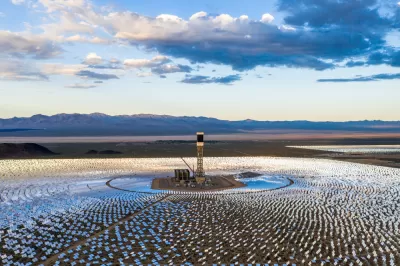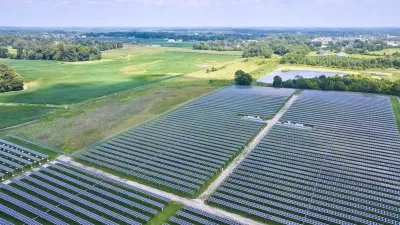The sprawling Mojave Desert plays a key role in carbon sequestration, storing around 10 percent of California’s carbon. But the fragile ecosystem is threatened by large-scale renewable energy projects.

A StoryMap from the Mojave Desert Land Trust outlines the role of the Southwestern desert in fighting climate change, highlighting the conflict between desert conservation and the rise of large-scale solar power generation projects. According to the MDLT, “Around 10% of the state’s carbon is sequestered underground in the desert’s plants and soil. But that carbon storage capacity is under threat from an unlikely source: large-scale renewable energy projects.”
“Arid soils provide the third largest global pool of carbon storage potential. In California, the desert accounts for nearly 10% of the state’s carbon sequestration.” But large-scale solar projects are often “poorly sited in pristine functioning ecosystems,” which can reduce the desert’s capacity to serve as an effective carbon sink.
According to MDLT, “To protect the desert’s fragile resources, we need to focus on leveraging renewable energy options with the least impact on functioning ecosystems.” To this end, “Several innovative technologies capable of assisting in our transition to clean energy, including rooftop and community solar, should be leveraged.” The article encourages boosting community and rooftop solar installations that utilize already developed land to create more solar energy production. “Recent studies have shown that rooftops across the United States offer enough acreage to generate the entire electrical demand of the country and more. One study found that installing 1 GW of rooftop solar would potentially avoid the disturbance of almost 5,200 acres of land – an area around the size of Monterey.”
See the linked StoryMap for more statistics and a visualization of California’s “development focus areas,” previously disturbed land recommended for renewable projects.
FULL STORY: How the desert will help us tackle climate change

Alabama: Trump Terminates Settlements for Black Communities Harmed By Raw Sewage
Trump deemed the landmark civil rights agreement “illegal DEI and environmental justice policy.”

Planetizen Federal Action Tracker
A weekly monitor of how Trump’s orders and actions are impacting planners and planning in America.

How Atlanta Built 7,000 Housing Units in 3 Years
The city’s comprehensive, neighborhood-focused housing strategy focuses on identifying properties and land that can be repurposed for housing and encouraging development in underserved neighborhoods.

In Both Crashes and Crime, Public Transportation is Far Safer than Driving
Contrary to popular assumptions, public transportation has far lower crash and crime rates than automobile travel. For safer communities, improve and encourage transit travel.

Report: Zoning Reforms Should Complement Nashville’s Ambitious Transit Plan
Without reform, restrictive zoning codes will limit the impact of the city’s planned transit expansion and could exclude some of the residents who depend on transit the most.

Judge Orders Release of Frozen IRA, IIJA Funding
The decision is a victory for environmental groups who charged that freezing funds for critical infrastructure and disaster response programs caused “real and irreparable harm” to communities.
Urban Design for Planners 1: Software Tools
This six-course series explores essential urban design concepts using open source software and equips planners with the tools they need to participate fully in the urban design process.
Planning for Universal Design
Learn the tools for implementing Universal Design in planning regulations.
Jessamine County Fiscal Court
Caltrans
Institute for Housing and Urban Development Studies (IHS)
City of Grandview
Harvard GSD Executive Education
Toledo-Lucas County Plan Commissions
Salt Lake City
NYU Wagner Graduate School of Public Service





























